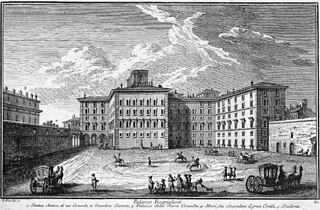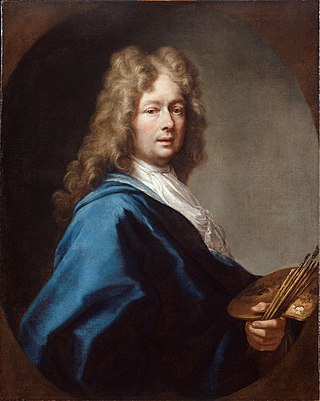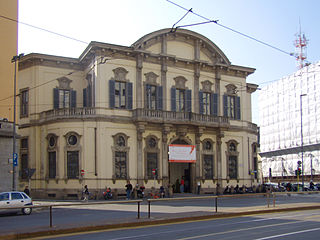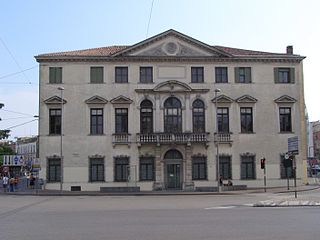
Giovanni Battista Tiepolo, also known as GiambattistaTiepolo, was an Italian painter and printmaker from the Republic of Venice who painted in the Rococo style, considered an important member of the 18th-century Venetian school. He was prolific, and worked not only in Italy, but also in Germany and Spain.

Ca' Rezzonico is a palazzo and art museum on the Grand Canal in the Dorsoduro sestiere of Venice, Italy. It is a particularly notable example of the 18th century Venetian baroque and rococo architecture and interior decoration, and displays paintings by the leading Venetian painters of the period, including Francesco Guardi and Giambattista Tiepolo. It is a public museum dedicated to 18th-century Venice and one of the 11 venues managed by the Fondazione Musei Civici di Venezia.

The Palazzo Pitti, in English sometimes called the Pitti Palace, is a vast, mainly Renaissance, palace in Florence, Italy. It is situated on the south side of the River Arno, a short distance from the Ponte Vecchio. The core of the present palazzo dates from 1458 and was originally the town residence of Luca Pitti, an ambitious Florentine banker.

Pellegrino Tibaldi, also known as Pellegrino di Tibaldo de Pellegrini, was an Italian mannerist architect, sculptor, and mural painter.

The Palazzo Pallavicini-Rospigliosi is a palace in Rome, Italy. It was built by the Borghese family on the Quirinal Hill; its footprint occupies the site where the ruins of the baths of Constantine stood, whose remains still are part of the basement of the main building, the Casino dell'Aurora. Its first inhabitant was the famed art collector Cardinal Scipione Borghese, the nephew of Pope Paul V, who wanted to be housed near the large papal Palazzo Quirinale. The palace and garden of the Pallavicini-Rospigliosi were the product of the accumulated sites and were designed by Giovanni Vasanzio and Carlo Maderno in 1611–16. Scipione owned this site for less than a decade, 1610–16, and commissioned the construction and decoration of the casino and pergolata, facing the garden of Montecavallo. The Roman palace of this name should not be mistaken for the panoramic Villa Pallavicino on the shores of Lake Como in Lombardy.

The Palazzo Ducale di Mantova is a group of buildings in Mantua, Lombardy, northern Italy, built between the 14th and the 17th century mainly by the noble family of Gonzaga as their royal residence in the capital of their Duchy. The buildings are connected by corridors and galleries and are enriched by inner courts and wide gardens. The complex includes some 500 rooms and occupies an area of c. 34,000 m2, which make it the sixth largest palace in Europe after the palaces of the Vatican, the Louvre Palace, the Palace of Versailles, the Royal Palace of Caserta and the Castle of Fontainebleau. It has more than 500 rooms and contains seven gardens and eight courtyards. Although most famous for Mantegna's frescos in the Camera degli Sposi, they have many other very significant architectural and painted elements.

Cesare Nebbia (c.1536–c.1614) was an Italian painter from Orvieto who painted in a Mannerist style.

Stefano Maria Legnani also known as "Legnanino" was an Italian painter of the late Baroque period, active mainly in Milan. He is considered one of the most innovative exponents of the Milanese school of painting of around the turn of the 17th and 18th centuries.

The Royal Palace of Milan was the seat of government in the Italian city of Milan for many centuries. Today, it serves as a cultural centre and it is home to international art exhibitions. It spans through an area of 7,000 square meters and it regularly hosts modern and contemporary art works and famous collections in cooperation with notable museums and cultural institutions from across the world. More than 1,500 masterpieces are on display annually.

The Messina Palace, also known as Palazzo Messina, is a palace located at No 141 and 141A Strada San Cristoforo in Valletta, Malta. It was built by Fra Pietro La Rocca, Prior of Santo Stefano, towards the end of the 16th century and was once part of a grander palace called Casa Rocca Grande. The property has been occupied by the German-Maltese Circle since 1975, who purchased the building from the Stilon family in 1989.

Palazzo Marino is a 16th-century palace located in Piazza della Scala, in the centre of Milan, Italy. It has been Milan's city hall since 9 September 1861. It borders on Piazza San Fedele, Piazza della Scala, Via Case Rotte and Via Tommaso Marino.

Giovanni Battista Sassi was an Italian painter, active mainly in Milan and other areas of Lombardy, who painted in a late-Baroque and Rococo style.

Benedetto Innocenzo Alfieri was an Italian architect, a representative of the late-Baroque or Rococo style.

Palazzo Sormani is a historic building of Milan, Italy, and the seat of the central public library of Milan. It is located at number 6 in Corso di Porta Vittoria, in the Zone 1 administrative division of the city.

Giovanni De Min was an Italian painter and engraver, active in a Neoclassic style.
The Palazzo Marigliano, also known as Palazzo di Capua is a Renaissance-style palace in Central Naples, Italy. It is located on the Via San Biagio dei Librai number 39.

The Palazzo Leoni Montanari is a late Baroque palace located in Contra’ San Corona number 25 in central Vicenza in the Veneto region of Italy. It now houses exhibition rooms, meeting places, and art collections owned by the bank Intesa Sanpaolo.
The Palazzo Costa is a Baroque style palace located on Via Roma #80 in Piacenza, Region of Emilia Romagna, Italy. The Museo Ambientale displaying period art and artifacts is now hosted by part of the palace.

Palazzo Cavriani is an aristocratic palace with gardens located in Mantua, Italy. The palace is also sometimes referred to as the Palazzo Gonzaga-Spolverini, but the palace belonging to those families was either razed or subsumed into the present neoclassical structure and garden.

The Palazzo Cavalli alle Porte Contarine, also called the Palazzo Cavalli agli Eremitani is a Renaissance-style palace located at the intersection of Corso Giuseppe Garibaldi and Via Giacomo Matteotti in Padua, region of Veneto, Italy. In 2019, it is owned by the University of Padua and houses the University's collections of geology and paleontology in the Museo della Natura e dell’Uomo.


















